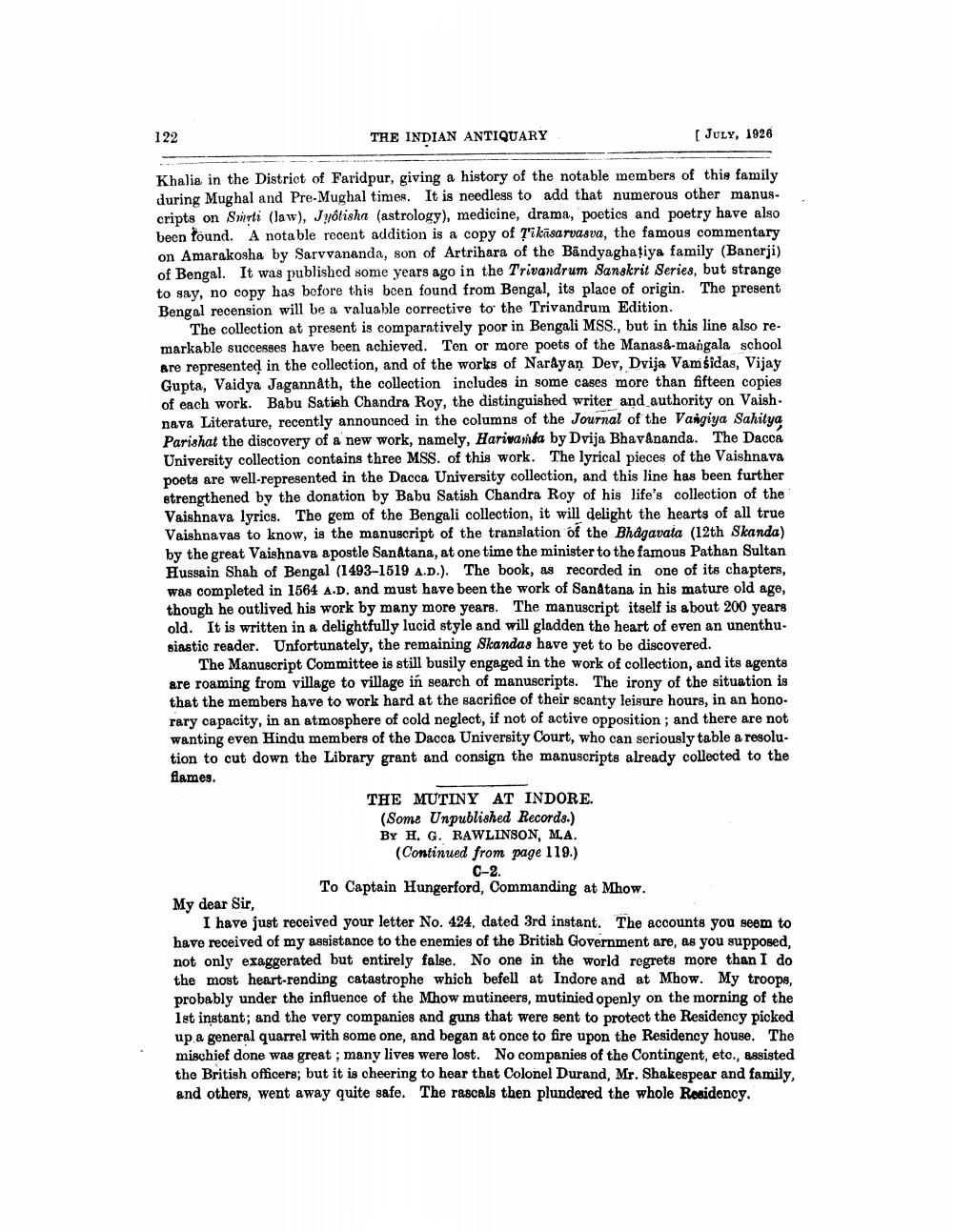________________
122
THE INDIAN ANTIQUARY
[ JULY, 1926
Khalia in the District of Faridpur, giving a history of the notable members of this family during Mughal and Pre-Mughal times. It is needless to add that numerous other manuscripts on Sniti (law), Jyotisha (astrology), medicine, drama, poetics and poetry have also been found. A notable recent addition is a copy of s'i kasarvasva, the famous commentary on Amarakosha by Sarvvananda, son of Artrihara of the Bandyaghatiya family (Banerji) of Bengal. It was published some years ago in the Trivandrum Sanskrit Series, but strange to say, no copy has before this been found from Bengal, its place of origin. The present Bengal recension will be a valuable corrective to the Trivandrum Edition.
The collection at present is comparatively poor in Bengali MSS., but in this line also remarkable successes have been achieved. Ten or more poets of the Manasa-mangala school are represented in the collection, and of the works of Narayan Dev, Dvija Vamsidas, Vijay Gupta, Vaidya Jagannath, the collection includes in some cases more than fifteen copies of each work. Babu Satish Chandra Roy, the distinguished writer and authority on Vaishnava Literature, recently announced in the columns of the Journal of the Vangiya Sahitya Parishat the discovery of a new work, namely, Harirasida by Dvija Bhavananda. The Dacca University collection contains three MSS. of this work. The lyrical pieces of the Vaishnava poets are well-represented in the Dacca University collection, and this line has been further strengthened by the donation by Babu Satish Chandra Roy of his life's collection of the Vaishnava lyrics. The gem of the Bengali collection, it will delight the hearts of all true Vaishnavas to know, is the manuscript of the translation of the Bhagavata (12th Skanda) by the great Vaishnava apostle Sanatana, at one time the minister to the famous Pathan Sultan Hussain Shah of Bengal (1493-1519 A.D.). The book, as recorded in one of its chapters, was completed in 1564 A.D. and must have been the work of Sanatana in his mature old age, though he outlived his work by many more years. The manuscript itself is about 200 years old. It is written in a delightfully lucid style and will gladden the heart of even an unenthu. siastic reader. Unfortunately, the remaining Skandas have yet to be discovered.
The Manuscript Committee is still busily engaged in the work of collection, and its agents are roaming from village to village in search of manuscripts. The irony of the situation is that the members have to work hard at the sacrifice of their scanty leisure hours, in an honorary capacity, in an atmosphere of cold neglect, if not of active opposition, and there are not wanting even Hindu members of the Dacca University Court, who can seriously table a resolution to cut down the Library grant and consign the manuscripts already collected to the flames.
THE MUTINY AT INDORE.
(Some Unpublished Records.) BY H. G. RAWLINSON, M.A. (Continued from page 119.)
C-2. To Captain Hungerford, Commanding at Mhow. My dear Sir,
I have just received your letter No. 424, dated 3rd instant. The accounts you seem to have received of my assistance to the enemies of the British Government are, as you supposed, not only exaggerated but entirely false. No one in the world regrets more than I do the most heart-rending catastrophe which befell at Indore and at Mhow. My troops, probably under the influence of the Mhow mutineers, mutinied openly on the morning of the 1st instant; and the very companies and guns that were sent to protect the Residency picked up a general quarrel with some one, and began at once to fire upon the Residency house. The mischief done was great ; many lives were lost. No companies of the Contingent, etc., assisted the British officers; but it is cheering to hear that Colonel Durand, Mr. Shakespear and family, and others, went away quite safe. The rascals then plundered the whole Residency.




